|
| |
3 Falke Bio. The first Todd-AO Installation in the Nordic countries
Denmark, 23.10.1958 - 14.12.1982
|
This article first appeared in
..in 70mm
The 70mm Newsletter
|
|
Written and photographed by: Thomas Hauerslev. Most pictures taken February 7,
1982 by author except when noted. |
Issue 52, March 1998 |
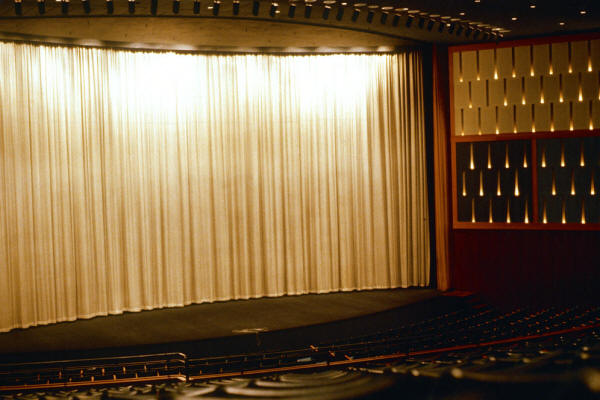 The
3 Falke Bio had 1000 seats in stadium
style seating, a huge curved 70mm screen and 6-track stereo. There were two sets of curtains and individual masking
for all formats. The 3 Falke Bio seen here in 1982. The
3 Falke Bio had 1000 seats in stadium
style seating, a huge curved 70mm screen and 6-track stereo. There were two sets of curtains and individual masking
for all formats. The 3 Falke Bio seen here in 1982.
3 Falke Bio was the best cinema I have ever experienced. It was quite simply
The Perfect Show in Todd-AO, as the 1955 tag line went. I was very impressed by the sheer
SIZE of the cinema
when I was 15 and saw my first film at that cinema. The screen was wide, curved
and very, very big. It was a very short, almost square-shaped, auditorium giving
an enhanced sense of a BIG screen. The 3 Falke Bio had 1000 seats in stadium
style seating, a huge curved 70mm screen and 6-track stereo. The 70mm projectors
were the Philips DP70. There were two sets of curtains and individual masking
for all formats.
I felt enveloped in the film when the picture filled my entire field of view.
Seeing films on THAT huge screen meant something to me and I am certain this
experience started my interest in Todd-AO history, DP70s and the cinema
experience in general. Unhappy with gymnasium, I dropped out of school and began
as a projectionist apprentice in April 1982 at the 3 Falke Bio. I was very happy
working there. My debut as a projectionist was a terrible 35mm Technicolor print
of "Quo Vadis" with several stops during the performance. Unfortunately, the 3 Falke Bio closed
a few month later, in December 1982 and I lost my dream job. I managed to save the
letters "B I O" from the façade, which has now been sitting in our living room for
MANY years. Every evening when the pixie dust light is radiating out of the
three letters, I am reminded of Todd-AO and 3 Falke Bio.
By the time of the closure, 3 Falke Bio was regarded by many people as the best
cinema that ever existed in Denmark. As 40 years have now passed by since
closure, only a few projectionists and devoteés of 70mm film will remember it any
longer. For those who do, and who are old enough to remember, it is sadly missed
and vividly regarded as the best cinema to watch 70mm and 6-Track Stereophonic
Sound in Copenhagen, and maybe in Denmark. This is my story about the 3 Falke Bio.
We are in the 1950s. A decade of hope, teenagers and big screens in the cinema.
One innovative movie format caused particular attention. A new film,
"Oklahoma!", opened
opened at the Rivoli theatre in New York
in October 1955 using the revolutionary new wide screen
process, Todd-AO.
The film became an instant hit and soon European exhibitors took notice
of the success. In the 1950s, the municipal management of Frederiksberg, a borough inside Copenhagen, realized that the city was growing and a new City Hall
was needed. The demolition of the old building made way to build the "Falconercenter" - a modern hotel, concert, conference and cinema complex with shops and restaurants. The architect was Ole Hagen (1913 - 1984) and his work was revolutionary for its time. He built an 18-floor hotel with a 1200-person conference centre/music theatre and a 1000 seat cinema. The cinema became the 3 Falke Bio and it was the first cinema in Scandinavia built to
Todd-AO specifications. The
first European Todd-AO installation opened in Rome (Adriano) on February
14, 1957 and a month later, Germany followed with the first
purpose-built Todd-AO cinema in Europe (The
"Savoy" in Hamburg). The first
Todd-AO cinema in Scandinavia was the 3 Falke Bio in Denmark.
|
More in 70mm reading:
Gallery
3 Falke Bio, Denmark
70mm Cinemas and Film in Denmark
Three Great Danish 70mm Cinemas
•
Go to
Kinopalæet
|
Imperial Bio |
Imperial Bio - Design for Copenhagen
You are in
the Show with Todd-AO
DP70s in
Denmark
|
|
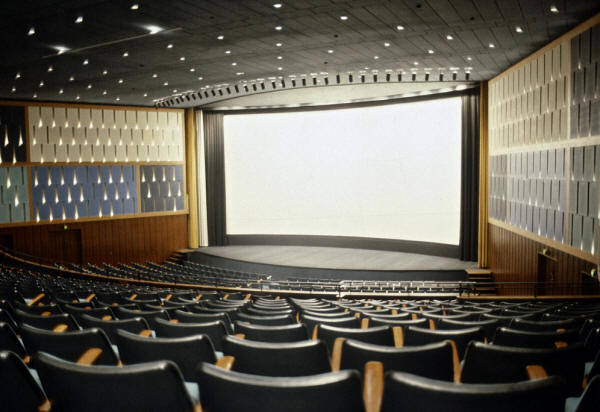 This
is what made the 3 Falke Bio famous. The Todd-AO screen. A magnificent 17,6 meters wide (58 ft) and 8 meters tall (26 ft). The depth of the
curve was 2,7 meters (9 ft). The screen was the entire front ”wall”
which gave a fantastic illusion of looking out of a window. Black
masking could be moved up and down and sideways to accommodate every
thinkable aspect ratio in all 70mm and 35mm formats. This
is what made the 3 Falke Bio famous. The Todd-AO screen. A magnificent 17,6 meters wide (58 ft) and 8 meters tall (26 ft). The depth of the
curve was 2,7 meters (9 ft). The screen was the entire front ”wall”
which gave a fantastic illusion of looking out of a window. Black
masking could be moved up and down and sideways to accommodate every
thinkable aspect ratio in all 70mm and 35mm formats.
The 3 Falke Bio opened to the public on Friday October 24, 1958. The night
before had been an invitational premiere for special guests and government
officials. The architect and designer, Mr. Ole Hagen (1913 - 1984), was a famed Danish
architect, responsible for numerous schools, public buildings and houses. His
company Ole Hagens Tegnestue was the largest architectural firm in Denmark for
many years. In 1959 he also designed the Cinerama theatre in Copenhagen, known
as Kinopalæet.
The 3 Falke Bio had 1000 seats but was far from being the largest cinema in
terms of seating capacity in Denmark at that time. Several Copenhagen cinemas
had more seats: The Nora (1184), The Palads Teatret (1549), The Palladium
(1347), The Saga (1692) and World Cinema (1575). In terms of screen size and
film width, however, 3 Falke Bio beat them all. Todd-AO, Big Screen and 6-track
stereophonic sound were all slogans that made 3 Falke Bio famous. A sign with
neon lights and 24-sheet poster always decorated the front.
The licensee to operate the cinema was awarded to Liberalt Oplysningsforbund and
in August, 1958 they hired Mr. August A. Andersen (1910 - 1990) to be the
manager of their new prestige cinema. Mr. Andersen had begun his career in the
cinema business in the late 1920s as an usher and later as a projectionist at
the Metropol and Palladium cinemas in central
Copenhagen. Prior to becoming
manager of the 3 Falke Bio he came from positions at Paramount and Warner
Brothers distribution. Mr. Andersen stayed at 3 Falke Bio until his retirement June
31, 1977, nearly 20 years later.
At 2 PM October 16, 1958 the architect and the manager opened the doors to the
new cinema for the press. They explained the new film format Todd-AO, the screen
size and the sound system and how it all worked together. At this point it was
announced that
"South
Pacific" in Todd-AO would be the first film at 3 Falke
Bio.
"It
is going to be a tremendous success and [Opening night] will be sold out
before the craftsmen are gone".
Mr. Anderson enthusiastically told the
admiring writers. He had seen "South Pacific" in
London at the
Dominion (UK
Todd-AO birth place) and
predicted a six-week run at 3 Falke Bio. Opening night was sold-out in less than
an hour, and "South Pacific" stayed at 3 Falke Bio for an impressive, and
unprecedented, 3½ year run. Two periods: 72½ and 112 weeks, or 184 weeks total.
It was finally taken off on February 14, 1963, 2056 performances later.
|
|
|
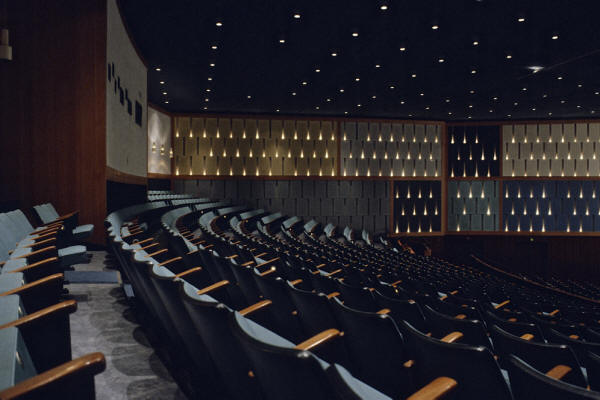 3 Falke Bio was built like an amphitheatre with 28 rows of seats. All rows were
curved to provide the best possible sightlines to the screen. The seats, with
teak arm rests, had turquoise upholstery and were made by the Danish factory
“Odense Stole- og Møbelfabrik”. 3 Falke Bio was built like an amphitheatre with 28 rows of seats. All rows were
curved to provide the best possible sightlines to the screen. The seats, with
teak arm rests, had turquoise upholstery and were made by the Danish factory
“Odense Stole- og Møbelfabrik”.
3 Falke Bio was built like an amphitheatre with 28 rows of seats. All rows were
curved to provide the best possible sightlines to the screen. The first third of
the seats were the first 11 rows on an slightly upward sloping floor from the
screen and stage bottom. Row 12 was raised 2 meters (6 ft) from the floor. The
succeeding 16 rows climbed steeply up to the back of the cinema. The seats, with
teak arm rests, had turquoise upholstery and were made by the Danish furniture factory
“Odense Stole- og Møbelfabrik”. The floor was dark-stained pine with carpets on
the stairs. The ceiling was dark blue with built-in downlights. Walls were
Asbestolux tiles with acoustic equalization, and a 15-Watt lamp was hidden
between each tile. The stage was illuminated by means of 81 ceiling-mounted
spotlights. The foyer was very small, and only had room for 500 people. There
were public phones and a concession kiosk. The boxoffice was outside in open
air. Staff rooms were on the 2nd and 3rd floor. Projection room was on the 4th
floor… and there was no elevator!
The projection room was well equipped. Two Philips all-purpose
DP70
projectors
with Mole Richardson lamp houses, one Ernemann 35mm projector, one Bang & Olufsen
(BOFA) V-6 six-track amplifier, a rewind table, and of course a coffee table for
the projectionists. Projection lenses for Todd-AO were American Optical
Cine-Apergons of exceptionally good quality – as the adverts said. The screen
was the largest ever seen in a Danish cinema. An impressive 17,6 meters wide (58
ft) and 8 meters tall (26 ft). The depth of the curve was 2,7 meters (9 ft). The
screen was the entire front ”wall” which gave a fantastic illusion of looking
out of a window. Black masking could be moved up and down and sideways to
accommodate every thinkable aspect ratios in all 70mm and 35mm formats. The 3 Falke
Bio’s Todd-AO screen was surpassed in size only by the
Cinemiracle (22 meters) and
Cinerama (29 meters)
screens later installed in Denmark. 3 Falke Bio's screen remained the largest in
Denmark until closure in 1982. Behind the screen were five sets of loudspeakers.
Each channel consisted of three woofers on top of each other mounted on a large
baffle made of wood. There was a tweeter on top of the baffle. 36 effects
speakers were located in the auditorium, hidden behind the Asbestolux walls. The
sound quality was remarkable according to trade press.
The most faithful guest was Mr. Ejner Knudsen who saw "South Pacific" more
often than
anyone else. He was 62 in 1958, father of four kids and a widower. He always
bought the same seat. Row number 1, seat number 1 (Nearest to the screen). He
was very fond of Ms. Mitzi Gaynor and saw her lovely talents more than 170
times. On several occasions he was given special attention when he had seen the
film a certain number of times. Saturday, July 16, 1960 on the occasion of his
going to see the film the 50th time, Mr. Andersen gave him a complete set of
movie stills, a bottle of cognac and a tour in the projection room. Mr. Andersen
later recalled the expenses for this award far exceeded the ticket income from
Mr. Knudsen. But the newspapers loved the story of the man who saw "South
Pacific" every Saturday from the same seat and it was good press coverage for
the cinema.
|
|
|
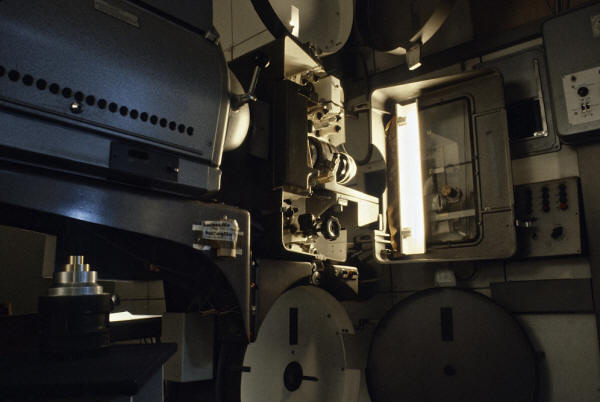 The
projection room was well equipped. Two Philips all-purpose DP70
projectors with Mole Richardson lamp houses, one Ernemann 35mm
projector, one Bang & Olufsen (BOFA) V-6 six-track amplifier, a rewind
table, and of course a coffee table for the projectionists. Projection
lenses for Todd-AO were American Optical Cine-Apergons of exceptionally
good quality – as the adverts said. The
projection room was well equipped. Two Philips all-purpose DP70
projectors with Mole Richardson lamp houses, one Ernemann 35mm
projector, one Bang & Olufsen (BOFA) V-6 six-track amplifier, a rewind
table, and of course a coffee table for the projectionists. Projection
lenses for Todd-AO were American Optical Cine-Apergons of exceptionally
good quality – as the adverts said.
"South Pacific" was shown every day at 19:30 (7:30 PM) and also at
16:00 (4 PM) during weekends and holidays.
The Todd-AO demonstration short film "The
Miracle of Todd-AO" accompanied "South
Pacific" from the first day. It never had a Danish title, but was affectionately
called ”Rutschebaneturen” (”The Roller Coaster Ride”) and was even advertised by
that name. The show at 3 Falke Bio was advertised all over Denmark and even in
Malmö, Sweden. The Todd-AO process made an unprecedented impact on the Danes.
Bus loads of people from all over the nation came to Copenhagen to visit 3 Falke
Bio to see ”The Greatest Show in Todd-AO”. 3 Falke Bio played ”South Pacific”
exclusively in Denmark, and at that time it was the biggest success in Denmark,
ever! Tourists also frequently came to 3 Falke Bio as films were always played
in original versions with subtitles in Danish. 262.368 guests saw "South
Pacific" during the first year.
In the following 12 years, 3 Falke Bio played many of the best 70mm films
Hollywood had to offer. Many films broke records and the cinema was well known
outside Denmark for its beautiful architecture and splendid viewing conditions
for 70mm. A few celebrities visited the cinema during premieres. Mr. Omar Sharif
("Lawrence of Arabia"), Mr. Peter Glenville ("Becket") and Mr. Rod Steiger
("Waterloo") all visited 3 Falke Bio. A premiere at 3 Falke Bio was always a
Copenhagen EVENT. The royal family, diplomats and politicians often visited the
cinema on these black tie/dark suit occasions.
3 Falke Bio management was approached in 1958 - even before the opening - and a
proposal was drafted to install Cinemiracle. The plans were considered, but
abandoned, because the screen would have been too small. A few years later a
proposal to install Cinerama was also considered. Again, 3 Falke Bio declined.
They had a good business with Todd-AO and saw no reason to change to Cinerama.
The DP70 projectors were re-equipped with new Zeiss’ 6500-Watt Xenon light
lamphouses in 1967. Dimension 150 was installed the same year at the expense of
20th Century Fox, only to be used for the prestigious premiere of "The Bible …
in
the beginning". The complete D-150 120-degree screen was installed
in three days and taken down again by the end of the run (3. March 1967
- 30. April 1967). Newspaper ads wrote it was the first D-150 installation in
Europe.
Sensurround was installed for
"Earthquake" in 1975. A Philips/Kinoton
non-rewind ST 270 platter system was also installed in 1975 and taken out again
1977/78. Dolby Stereo (A CP50 processor) and new speakers were installed for
"The Deer Hunter" in March 1979.
|
|
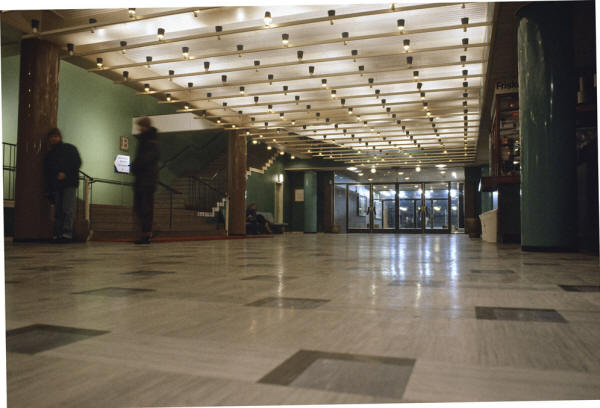 3
Falke Bio was way ahead of it's time in 1958 with a 1000 seats, style,
ambiance and "high impact" atmosphere. It was designed based on
Todd-AO recommendations on how to offer the audience the chance to be "in
the movies". 3
Falke Bio was way ahead of it's time in 1958 with a 1000 seats, style,
ambiance and "high impact" atmosphere. It was designed based on
Todd-AO recommendations on how to offer the audience the chance to be "in
the movies".
The first 12 years went by quickly, and the cinema rode on a long-standing wave
of successful 70mm films. Thanks to excellent management, good films and a
faithful audience, 3 Falke Bio remained a success for many years. Dark clouds
began to appear on the horizon, however, and audiences started to decline by
the early 1970s. Very few films lasted more than three months. Films were often
replaced after only two or three weeks, a far cry from the roaring 1960s when
films easily played more than six months. Only six films stayed on 3 Falke Bio's
vast curved screen for more than three months from 1970 until closure in 1982.
"The Godfather" (9 months), "The Great Gatsby" (5 months),
"Hello, Dolly!",
"Kelly's Heroes" and
"Earthquake" (all 4 months) and
"Close Encounters of the Third Kind"
(3 months). According to the late August Andersen, after 1977 the cinema
lost money. What went wrong? There were several reasons I suppose. Film making
changed, distribution/-exhibition changed, and audiences changed. There was a
general recession affecting all cinemas in Copenhagen. A lot of older cinemas
closed during the 1970s and many were replaced by a new form of cinemas; the
multiplex. Also, many films of the 1970s were "smaller", more intimate and
lower-budget types of movies that didn't require the immense Todd-AO screen.
3 Falke Bio's original audience was getting older too and perhaps lost interest in
going out to see films in the cinema. Maybe they preferred to stay home and
watch TV. The new generation of cinemagoers spent their money at the new
shoebox-sized cinemas located around Town Hall in central Copenhagen. As
revenues declined, 3 Falke Bio simply did not get the blockbusters anymore. And
as they didn't get the big movies, audiences stayed away even more. After Mr.
Andersen retired in 1977, four different managements tried to breathe new life
into 3 Falke Bio. At this point, the fight was probably already lost, but nobody
knew that yet. The new managements, with one exception, had no idea what to do
with the cinema. Eventually they gave up.
On July 1, 1980 Mr. Per Hauberg (age 28) realized his dream of becoming manager
of 3 Falke Bio. His passion for 70mm was well known by film distributors and
they willingly supported his desire to run the classic prints one last time. Mr.
Hauberg fought valiantly for 10 months to save "his" cinema with a colorful
mixture of 70mm- and 35mm re-runs. Thanks to his efforts many different 70mm
films were shown on the big screen, many of which had never been shown on 3 Falke Bio's giant screen before. That was the last opportunity to see and hear
70mm re-releases with six-track stereo in Copenhagen for many years to come. A
newspaper strike broke out in late April 1981, and without advertising it was
impossible to run the cinema. Mr. Hauberg was forced to shut down his operation
of the cinema in May 1981. He lost more than DKK 200.000 (USD 31.000) on his
dream. And incredibly, all 70mm prints were junked shortly afterwards.
Advertised performances of ”The Bible … in the beginning” on May 1, 2 and 3,
1981 was not shown. 3 Falke Bio went dark for the first time since 1958.
|
|
|
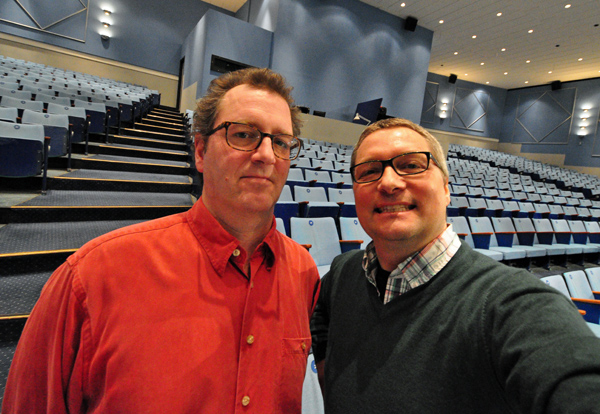 Widest
smile possible, interviewing Mr Oliver Michael Todd, a Todd-AO theatre.
And the location is what used to be 3 Falke Bio, on 5 March 2014. Where do you go
from there? Widest
smile possible, interviewing Mr Oliver Michael Todd, a Todd-AO theatre.
And the location is what used to be 3 Falke Bio, on 5 March 2014. Where do you go
from there?
Six months later in November 1981 3 Falke Bio reopened under yet another new management and ran until
December 1982. A very strange mixture of old and new films was shown, none of
which made any big business. 3 Falke Bio’s swan song as a Todd-AO cinema
included 70mm screenings of
“Battle of the Bulge”, “Earthquake” and the campy
“Ice Station Zebra”. “Zebra” was the last 70mm film to be shown on the curved
Todd-AO screen on 1. August 1982 completing a two-week run, only 12 years after
the original premiere 23. January 1970 on the same screen. 3 Falke Bio
officially closed after the last performance on Tuesday December 14, 1982, never
to reopen. The final film shown on the largest screen in Denmark was a 35mm
version of "Spartacus".
On January 17, 1983 the Todd-AO screen was taken down and replaced by a
considerably smaller flat screen on the rear wall. The new screen was simply a
cut-out piece of the big screen. The cinema continued for a while with film club
showings, and then it was over for good. The name was changed to 3 Falke Scenen
[3 Falke Stage] and the old neon sign was taken down. The Philips projectors
were sold in 1986, ironically the same year Warner Brothers seriously considered
re-opening the cinema as a multiplex, but it was too late. The owners of the
building were going to rebuild the entire theatre/ cinema/ hotel complex. The projection room
also disappeared in 1986 as part of the rebuilding. The first 11 rows of seats are also gone
and have been replaced by a large stage. Most of the auditorium still exists
today: for nearly 40 years after the closure of the cinema, it has been used
for theatre, concerts, TV recordings, lectures, meetings and interviews.
3 Falke Bio was way ahead of it's time in 1958 with 1000 seats, style,
ambiance and the "high impact" atmosphere. It was designed based on
Todd-AO recommendations on how to offer the audience the chance to be
"in the movies". Modern cinemas often fall short on cheap design,
but still owes a lot to this type of cinema, with a big screen covering
an entire wall, curved stadium seating, excellent sightlines, 70mm, and much
more. It's not a new invention. It was all done 60+ years ago.
One final touch of Todd-AO glory happened quite anonymously on March 5, 2014. I
had the honour of interviewing a gentleman by the name of
Oliver Michael Todd (1965-2015), who happened to
be working in Copenhagen as a teacher at that time. It was quite moving to sit and
listen to Oliver’s few, but nice recollections, about Todd-AO. A
BIG-SCREEN film process that
carry his name! We were only two people in the huge auditorium sitting in the
original seats from 1958. We imagined, listening carefully, we could still
hear the faint and distant echoes of magnetic sound and “Oklahoma!” in
THE SPLENDOUR OF TODD-AO in the former cinema. Oh, did I forget
to mention?
Oliver's grandfather happened to be a Broadway
Producer, the one and only Michael Todd.
|
|
The 70mm films at 3 Falke Bio
|
|
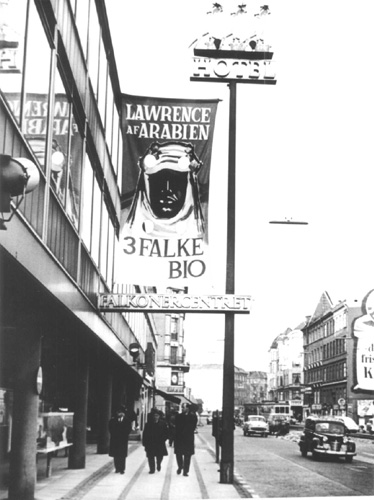 "Lawrence
of Arabia" poster on side walk in 1963. Picture from Thomas Hauerslev
collection. "Lawrence
of Arabia" poster on side walk in 1963. Picture from Thomas Hauerslev
collection.
Many 70mm films were shown several times. This list only notes the first time
each film was shown. All films listed here had their Danish premiere at 3 Falke
Bio except films noted *) = Re-run. Years 1974-1977 Researched by Per Hauberg
24.10.1958 "South Pacific" Scandinavian premiere
24.10.1958 "The Miracle of Todd-AO" Scandinavian premiere
29.03.1960 "Sleeping Beauty" *)
19.08.1960 "Porgy and Bess"
15.02.1963 "Oklahoma!"
15.02.1963 "The March of Todd-AO"
20.08.1963 "Mutiny on the Bounty"
15.10.1963 "Lawrence of Arabia"
15.06.1964 "West Side Story" *)
28.08.1964 "Becket"
26.12.1964 "My Fair Lady"
09.11.1966 "The Sound of Music" *)
03.03.1967 "The Bible…In the Beginning" in Dimension 150
20.11.1967 "The Dirty Dozen"
08.03.1968 "Doctor Dolittle"
22.04.1968 "The Comedians"
26.08.1968 "Gone With The Wind" European premiere
20.01.1969 "Where Eagles Dare" European premiere
06.06.1969 "Funny Girl"
23.01.1970 "Ice Station Zebra"
14.04.1970 "Hello, Dolly!"
10.11.1970 "Goodbye Mr. Chips!"
14.12.1970 "Kelly´s Heroes"
02.04.1971 "Waterloo"
14.04.1972 "Oliver!" *)
26.12.1974 "That's Entertainment"
30.01.1975 "Earthquake" in Sensurround
27.02.1976 "Ben Hur" *)
26.04.1976 "Battle of the Bulge" *)
26.12.1976 "Logans´s Run"
07.03.1977 "Cheyenne Autumn" *)
03.03.1978 "Close Encounters of the Third Kind"
24.01.1980 "Ryan´s Daughter" *)
01.02.1980 "Those Magnificent Men in their Flying Machines, or how I Flew From
London To Paris in 25 hours and 11 minutes"
23.07.1980 "The Great Race" *)
30.07.1980 "2001: A Space Odyssey" *)
18.08.1980 "MacKennas Gold" *)
18.08.1980 "Dersu Uzala" *)
03.10.1980 "Paint Your Wagon" *)
03.11.1980 "The Agony and the Ecstasy" *)
10.12.1980 "Doctor Zhivago" *)
05.01.1981 "The Sand Pebbles" *)
14.01.1981 "Camelot" *)
|
|
Top Five 70mm Box Office
Listed here are the 5 most successful films
in terms of audiences. All
presented in 70mm.
|
|
|
Title Boxoffice return in DKK |
Guests: |
Weeks: |
|
South Pacific 7.728.053 |
782.710 |
201 |
|
My Fair Lady 4.860.848 |
441.444 |
87,6 |
|
The Sound of Music 1.384.114 |
122.712 |
28 |
|
Lawrence of Arabia 922.581 |
88.984 |
23 |
|
The Dirty Dozen 1.001.029 |
80.595 |
15 |
| |
|
|
|
|
|
Source of Information
|
|
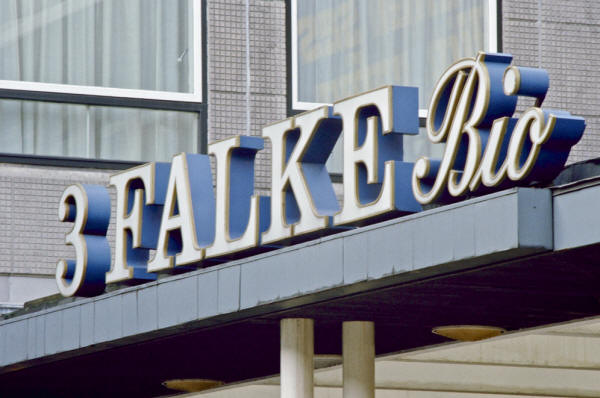 The
3 Falke Bio closed in December 1982, I managed to save the
letters "B I O" from the façade. Three letters which have now been sitting in our living room for
MANY years. Every evening when the pixie dust light is radiating out of the
three letters, I am reminded of Todd-AO and 3 Falke Bio. The
3 Falke Bio closed in December 1982, I managed to save the
letters "B I O" from the façade. Three letters which have now been sitting in our living room for
MANY years. Every evening when the pixie dust light is radiating out of the
three letters, I am reminded of Todd-AO and 3 Falke Bio.
•
Interviews with Mr. August A. Andersen (early 1980s) and information
from his his scrap books.
•
Description of 3 Falke Bio by Mr. P. Hummeluhr
dated December 2, 1958,
•
Politiken October 17, 1958.
•
Dagens Nyheder October
17, 1958.
•
Berlingske Tidende October 17, 1958.
•
Biografejerens Håndbøger.
|
|
|
|
|
Go: back
- top - back issues
Updated
22-01-25 |
|
|
 The
3 Falke Bio had 1000 seats in stadium
style seating, a huge curved 70mm screen and 6-track stereo. There were two sets of curtains and individual masking
for all formats. The 3 Falke Bio seen here in 1982.
The
3 Falke Bio had 1000 seats in stadium
style seating, a huge curved 70mm screen and 6-track stereo. There were two sets of curtains and individual masking
for all formats. The 3 Falke Bio seen here in 1982. 3
Falke Bio was way ahead of it's time in 1958 with a 1000 seats, style,
ambiance and "high impact" atmosphere. It was designed based on
Todd-AO recommendations on how to offer the audience the chance to be "in
the movies".
3
Falke Bio was way ahead of it's time in 1958 with a 1000 seats, style,
ambiance and "high impact" atmosphere. It was designed based on
Todd-AO recommendations on how to offer the audience the chance to be "in
the movies".  "Lawrence
of Arabia" poster on side walk in 1963. Picture from Thomas Hauerslev
collection.
"Lawrence
of Arabia" poster on side walk in 1963. Picture from Thomas Hauerslev
collection. The
3 Falke Bio closed in December 1982, I managed to save the
letters "B I O" from the façade. Three letters which have now been sitting in our living room for
MANY years. Every evening when the pixie dust light is radiating out of the
three letters, I am reminded of Todd-AO and 3 Falke Bio.
The
3 Falke Bio closed in December 1982, I managed to save the
letters "B I O" from the façade. Three letters which have now been sitting in our living room for
MANY years. Every evening when the pixie dust light is radiating out of the
three letters, I am reminded of Todd-AO and 3 Falke Bio.



 Widest
smile possible, interviewing Mr Oliver Michael Todd, a Todd-AO theatre.
And the location is what used to be 3 Falke Bio, on 5 March 2014. Where do you go
from there?
Widest
smile possible, interviewing Mr Oliver Michael Todd, a Todd-AO theatre.
And the location is what used to be 3 Falke Bio, on 5 March 2014. Where do you go
from there?